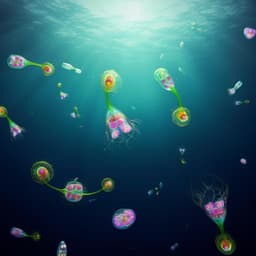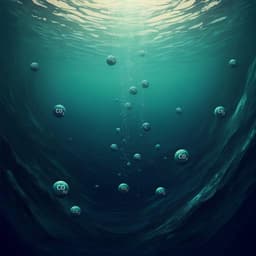
Biology
Salp blooms drive strong increases in passive carbon export in the Southern Ocean
M. Décima, M. R. Stukel, et al.
This groundbreaking research reveals how salp blooms in the Southern Ocean enhance the efficiency of the biological carbon pump, significantly impacting carbon export dynamics. Conducted by Moira Décima and colleagues, the study highlights the pivotal role of *Salpa thompsoni* in shifting microbial dynamics and boosting particle export rates.
~3 min • Beginner • English
Introduction
The Southern Ocean, covering approximately one-third of the global ocean, plays a central role in climate regulation through the biological carbon pump (BCP), which transfers photosynthetically fixed carbon to depth. Despite regional variability, the Southern Ocean contributes a significant portion (2–3 Pg C y−1) to global biological export. Understanding how climate-driven ecological changes alter BCP efficiency is therefore critical. Salps (gelatinous zooplankton) are widespread in the Southern Ocean and may be expanding poleward with warming, potentially displacing krill and reshaping food webs and carbon cycling. Salps efficiently filter a broad prey-size spectrum and produce large, fast-sinking fecal pellets, suggesting they could strongly enhance carbon export during blooms. However, it remains unclear whether salps increase export above that expected from concurrent high primary production or simply occur under conditions that already favor export. This study aims to quantify the impacts of salp blooms on microbial dynamics and passive carbon export by comparing paired salp-bloom and non-bloom sites across distinct water masses near New Zealand’s Chatham Rise. The specific goals are to: (i) determine the effect of salp grazing on the microplankton community; (ii) quantify differences in export flux under bloom and non-bloom conditions; (iii) test whether enhanced BCP during salp blooms is primarily driven by salp fecal pellets versus phytoplankton community structure; and (iv) assess whether salp blooms alter the taxonomic composition of exported particles.
Literature Review
Prior studies report elevated particulate organic carbon (POC) export associated with salp blooms in diverse regions, including the Lazarev Sea and Western Antarctic Peninsula, as well as the Sargasso Sea, northern Arabian Sea, and California Current. Salps’ high ingestion rates, capacity for extensive blooms, broad prey-size retention (submicron to >1 mm), and production of rapidly sinking fecal pellets underpin their potential to enhance ocean carbon sequestration. Global modeling suggests salps contribute substantially to export, but mechanistic, in situ process studies quantifying how blooms alter complete carbon budgets are rare. Because blooms often coincide with elevated primary production, it is unresolved whether salps cause additional export of material that would otherwise remain in the euphotic zone, or if they track conditions that are inherently export-prone. Disentangling these effects requires simultaneous measurements of phytoplankton growth, micro- and mesozooplankton grazing, salp standing stocks and grazing/fecal pellet production, and multi-method carbon export estimates on appropriate time scales—datasets that have been lacking.
Methodology
Study region and design: The SalpPOOP study was conducted near the Chatham Rise, east of New Zealand, where nitrogen-limited Subtropical (ST) and iron-limited Subantarctic (SA) waters converge to form the Subtropical Front. Five Lagrangian experimental cycles (3–7.5 days each) followed discrete water parcels: two in ST and three in SA (including one SA Southland Current-influenced site, SA-Sc). Each water mass included a salp-bloom and a non-bloom (control) site for quasi-controlled comparisons. Arrays tracked mixed-layer waters using drogues and Iridium beacons.
Repeated measurements: Hydrography (CTD profiles of temperature, salinity, oxygen, PAR), nutrients (NO3, NH4, DRP, silicate), phytoplankton biomass and size structure (total and size-fractionated chlorophyll a; HPLC pigments), phytoplankton physiology (FRRF: Fv/Fm and PSII QA reoxidation kinetics), phytoplankton growth and microzooplankton grazing rates (daily two-treatment dilution experiments at six euphotic depths with nutrient amendments and photoacclimation corrections), net primary production (24-h 14C-bicarbonate incubations at six euphotic depths), microbial community composition (18S rDNA for protists; 16S rRNA gene for Bacteria/Archaea; dada2/phyloseq pipelines; PERMANOVA), and zooplankton/salp communities (bongo tows, 200-µm mesh, day/night; identification, staging into oozooids/blastozooids, size spectra and biomass).
Salp grazing and fecal pellet production: Salp gut pigments (chl a + phaeo) were measured to estimate size-specific grazing (Gpig) using fitted power functions and gut passage time (GPT) scaled by temperature (Q10=2). Daily grazing assumed 14 h day/10 h night. Fecal pellet (FP) production was estimated by two approaches: (1) Fprod_Gpig = grazing × egestion efficiency (EE=0.36 from S. thompsoni assimilation efficiencies), and (2) Fprod_iversen using published Antarctic length–FP production and carbon-per-pellet relationships, scaled to in situ temperature (Q10=2). Errors were propagated from abundance and tow variability.
Passive export flux: Surface-tethered, free-drifting cylindrical Particle Interceptor Traps (PIT; 7 cm ID, 8:1 aspect ratio with baffles) were deployed typically at depths near Ez+ (~70 m), 100, 300, and 500 m. Trap contents were processed to remove swimmers; POC/PON (elemental analysis), chlorophyll a, C:234Th ratios, DNA metabarcoding (18S) and microscopy were obtained. Salp FP contributions were quantified by imaging >200-µm fractions, measuring pellet morphometry, and applying an empirical carbon:volume relationship derived from incubated salp pellets. Flux attenuation with depth was characterized and, when needed, power-law fits were applied.
234Th–238U disequilibrium: Small-volume 234Th profiles (CTD, 4 L) with chemical co-precipitation, beta counting, and ICP-MS tracer yields were used to estimate export at PIT depths via steady-state (SS) and, where appropriate, non-steady-state (non-SS) models. Measurement uncertainties were fully propagated. Comparisons between PIT POC flux and 234Th-derived fluxes assessed temporal integration differences and non-steady dynamics.
Sediments: Multicorer surface sediments (top 1 cm) were collected once per cycle for 18S metabarcoding to detect salp DNA deposition.
Analytical/statistical approaches: Community analyses used PERMANOVA and NMDS; differential abundance between water column and PIT protists used DESeq2; export efficiencies Ez (POC flux/NPP at Ez) and T100 (flux transmission to Ez+100 m) were computed to quantify BCP efficiency (Ez × T100).
Key Findings
- Salp blooms substantially enhanced passive POC export compared to nearby non-salp waters. PIT measurements showed 2- to 8-fold higher POC flux in salp areas (average ~5-fold; some ratios up to ~10 depending on depth/location).
- Absolute POC fluxes: below the euphotic zone (~70 m), salp cycles had 80–210 mg C m−2 d−1 (SA: 80–130; ST: 210). At 300 m, salp cycles had 42–60 mg C m−2 d−1 (SA) and 119 mg C m−2 d−1 (ST). Non-salp areas were much lower: 25–33 mg C m−2 d−1 in the epipelagic and 7±6 (SA) to 19±6 (ST) mg C m−2 d−1 at 300 m.
- Export efficiency Ez and transmission T100 increased with salps. In ST, Ez rose from 0.05 (non-salp) to 0.46 (salp), exporting up to 46% of NPP below the euphotic zone. In SA, Ez rose from 0.11 to 0.42 with salps. T100 increased from ~0.52 (non-salp) to 0.65–0.70 in salp locations as blooms progressed.
- Overall BCP efficiency (Ez × T100) increased from ~5–7% in non-salp/early-bloom SA to ~15% (Salp SA-Sc B) and ~27–28% at mature salp bloom sites (SA and ST), among the highest efficiencies reported globally.
- Salp fecal pellets were a major component of sinking flux: intact, recognizable salp pellets constituted 20–40% of POC at the base of the euphotic zone and up to ~50% at 300–500 m. Comparisons of estimated egestion to pellets in traps suggested 24–112% (Fprod_Gpig basis) and 14–57% (Fprod_iversen basis) of estimated FP production reached ≥200 m, varying with bloom stage and pellet size.
- Salp grazing strongly impacted phytoplankton dynamics. In all salp locations, net phytoplankton rates of change were negative; early bloom salp grazing was comparable to microzooplankton and reduced NPP by ~1/3 between early and later periods in Salp SA-Sc. Microzooplankton grazing remained substantial across sites.
- Phytoplankton communities differed by water mass: SA salp sites had higher contributions of >20 µm cells (diatoms; fucoxanthin, Bacillariophyta), whereas ST sites were dominated by prymnesiophytes (19-hexanoyloxy/19-butanoyloxyfucoxanthin, 18S data). Highest NPP occurred at Non-salp ST; lowest at Non-salp SA.
- Salp blooms modified the composition of exported microplankton. NMDS and DESeq2 analyses indicated higher similarity between water column and PIT communities at salp sites (notably Salp SA-Sc and Salp ST). In ST, coccolithophore Gephyrocapsa oceanica was preferentially exported at the salp site but not at the non-salp ST, implying salp-mediated packaging/aggregation of prymnesiophytes and potential effects on inorganic carbon flux.
- 234Th–238U results corroborated elevated, temporally integrated export during salp blooms, with strong 234Th deficiencies in salp cycles (notably Salp ST throughout the water column). Non-steady-state behavior was evident (e.g., Salp SA), indicating increasing export over time.
- Bloom evolution influenced flux: early-stage blooms (large oozooids, larger pellets) yielded high direct pellet contributions; later stages (small blastozooids) showed more pellet fragmentation/reworking and enhanced mesopelagic signal, consistent with regional advection from west to east across the Chatham Rise.
Discussion
The study demonstrates that salp blooms are powerful drivers of passive carbon export and BCP efficiency in the Southern Ocean sector east of New Zealand. By directly comparing paired salp and non-salp sites within the same water masses and quantifying full food-web processes, the results show that elevated export cannot be attributed simply to higher primary production or phytoplankton size structure. Instead, salp fecal pellet production and sinking dominate the export enhancement. Salp grazing shifts phytoplankton from net growth (in ST controls) to net loss, and accelerates declines in standing stock in SA waters already characterized by tight microbial coupling. The composition of exported particles is also altered, with increased congruence between water column and sinking communities at salp sites and preferential export of prymnesiophytes (e.g., Gephyrocapsa oceanica) in ST salp waters, suggesting salp-mediated impacts on both organic and inorganic carbon fluxes. Temporal and spatial patterns indicate that bloom stage and advection modulate export magnitude and transmission, with later-stage and downstream sites showing elevated mesopelagic signatures consistent with reworked/disaggregated fecal material and longer integration signals captured by 234Th. Collectively, the findings highlight zooplankton community structure (particularly salps) as a key control on Southern Ocean biogeochemistry, potentially as important as changes in NPP. In a warming climate where salps may expand and increase, significant shifts in carbon sequestration pathways, bloom dynamics, and export composition are likely.
Conclusion
This study provides the first comprehensive, whole food-web process assessment of how salp blooms alter microbial dynamics and the BCP in the Southern Ocean near the Chatham Rise. Salp blooms increase passive POC export by roughly fivefold on average and elevate BCP efficiency to among the highest observed globally (~27–28%), with up to 46% of NPP exported below the euphotic zone during blooms. The enhancement is largely attributable to salp fecal pellet production and sinking, with additional alterations in the taxonomic composition of exported particles. These results underscore that changes in zooplankton community structure, not solely NPP, can strongly regulate export efficiency. Future research should: (i) disentangle causal drivers enabling salp bloom initiation across different phytoplankton regimes; (ii) quantify variability across similarly staged blooms under differing physical and nutrient conditions; (iii) better resolve the fate of fragmented pellets and downstream/reworked flux; and (iv) incorporate additional salp-mediated pathways (sinking carcasses, active transport via vertical migration) into carbon budgets and models to constrain the full salp impact on sequestration.
Limitations
- Causality not resolved: The study design contrasts salp vs non-salp locations but was not designed to determine what phytoplankton or environmental conditions trigger blooms; initial community differences complicate inference.
- Temporal non-steady state: Rapid bloom evolution and advection produced non-steady conditions (e.g., Salp SA), adding uncertainty to 234Th-based export estimates and comparisons with shorter-integration PIT fluxes.
- Pellet fragmentation/reworking: Small and late-stage pellets disaggregate and sink slowly, making quantitative attribution of export to salp pellets conservative and uncertain.
- Spatial heterogeneity/advection: Downstream sites may integrate upstream bloom export, complicating local source–sink attribution.
- eDNA/sediment uncertainties: Persistence and degradation rates of salp DNA in sediments are not precisely known, limiting temporal resolution of deposition signals; minimal sedimentation at some sites (e.g., crest of Chatham Rise) may bias sediment DNA contrasts.
- Bloom stage mismatch: Comparisons across sites involved different salp size/stage structures, limiting direct rate comparisons and generalization.
Related Publications
Explore these studies to deepen your understanding of the subject.







